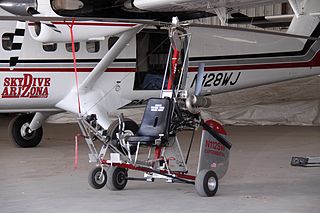Related Research Articles

The Preceptor N3 Pup is a family of ultralight, tube-and-fabric, high-wing, homebuilt aircraft. Kits were produced and marketed by Preceptor Aircraft, of Rutherfordton, North Carolina. The company was operating on a limited basis, actively selling plans online, but seems to have gone out of business in 2016.

The Little Wing Autogyro is a series of conventional one and two place autogyros with a tractor engine layout using modern engines and produced by Little Wing Autogyros, Inc. of Mayflower, Arkansas.
The Pop's Props Cloudster is a single seat, open-cockpit, parasol wing, single-engine monoplane, that was first flown in 1995. The aircraft was produced by Pop's Props of Cooksville, Illinois and made available as plans or in kit form. The company is no longer in business and kit production has been transferred to Simplex Aeroplanes of Old Saybrook, Connecticut.

The Carlson Sparrow is a family of American, high wing, strut-braced, single engine, ultralight aircraft that was designed by Ernst W. Carlson and produced by Carlson Aircraft of East Palestine, Ohio and later Skyline Technologies of Salem, Ohio for amateur construction.
The St Croix Excelsior is an American ultralight aircraft that was designed by Chad Wille and Charles Wille, produced by St Croix Aircraft of Corning, Iowa and first flown in 1980. The aircraft was supplied in the form of plans for amateur construction with some hard-to-make parts available as well as partial kits.
The Teman Mono-Fly is an American ultralight aircraft that was designed by structural engineer Bob Teman and produced by Teman Aircraft Inc. The aircraft was supplied as a kit for amateur construction and later as a factory-completed aircraft.
The Rotec Panther is an American ultralight aircraft that was designed and produced by Rotec Engineering, introduced in 1984. The aircraft was supplied as a kit for amateur construction.
The Air Command Commander is an American autogyro that was designed and produced by Air Command International, with its first flight in 1984. Production was completed by 2003. The aircraft was supplied as a kit for amateur construction.

The Brock KB-3 is an American autogyro that was designed by Ken Brock, produced by Ken Brock Mfg and introduced in 1985. The aircraft was supplied as a kit for amateur construction and was also available as plans.
The Sport Copter Lightning is an American autogyro, designed and produced by Sport Copter of Scappoose, Oregon. The aircraft is supplied as a kit for amateur construction.
The American Sportscopter Ultrasport 254 is an American helicopter that was designed and produced by American Sportscopter and first flown in July 1993. The aircraft was produced by Light's American Sportscopter Inc from 1999. The aircraft was supplied as a kit for amateur construction.
The Vortech Kestrel Jet is an American tip-jet helicopter that was designed in the 1980s. Kits for amateur construction were originally provided by Vortech and plans remain available.
The Taggart GyroBee is an American autogyro that was designed by Ralph E. Taggart of Michigan State University and made available as free documentation. The aircraft is also produced in kit form by Star Bee Gyros of Worcester, Massachusetts for amateur construction.
The North American Rotorwerks Pitbull Ultralight is an American autogyro, designed and produced by North American Rotorwerks of Tukwila, Washington. When it was available the aircraft was supplied as a kit for amateur construction, but by 2013 production had been suspended.
The Air Command Commander Sport is an American autogyro that was designed and produced by Air Command International of Wylie, Texas. Now out of production, when it was available the aircraft was supplied as a kit for amateur construction.
The Amax Double Eagle TT is an Australian autogyro that was designed and produced by Amax Engineering of Donvale, Victoria in the late 1990s. Now out of production, when it was available the aircraft was supplied as a kit for amateur construction.
The Vortech Sparrow is an American autogyro that was produced by Vortech of Fallston, Maryland. When it was available the aircraft was supplied in the form of plans for amateur construction. Vortech also supplied rotor blades and some key parts for the design.
The Raven Explorer I is an American autogyro that was designed and produced by Raven Rotorcraft of Boulder Colorado and later El Prado, New Mexico, introduced in the 1990s. Now out of production, when it was available the aircraft was supplied as a kit, for amateur construction.
The Rotorwing-Aero 3D-RV is an American autogyro that was designed by Monte Hoskins and produced by Rotorwing-Aero of Salt Lake City, Utah, introduced in 1989. Now out of production, when it was available the aircraft was supplied in the form of plans for amateur construction.
The Calumet Snobird Explorer is an American autogyro produced by Calumet Motorsports of Lansing, Illinois, introduced in May 1997. Now out of production, when it was available the aircraft was supplied as a kit for amateur construction.